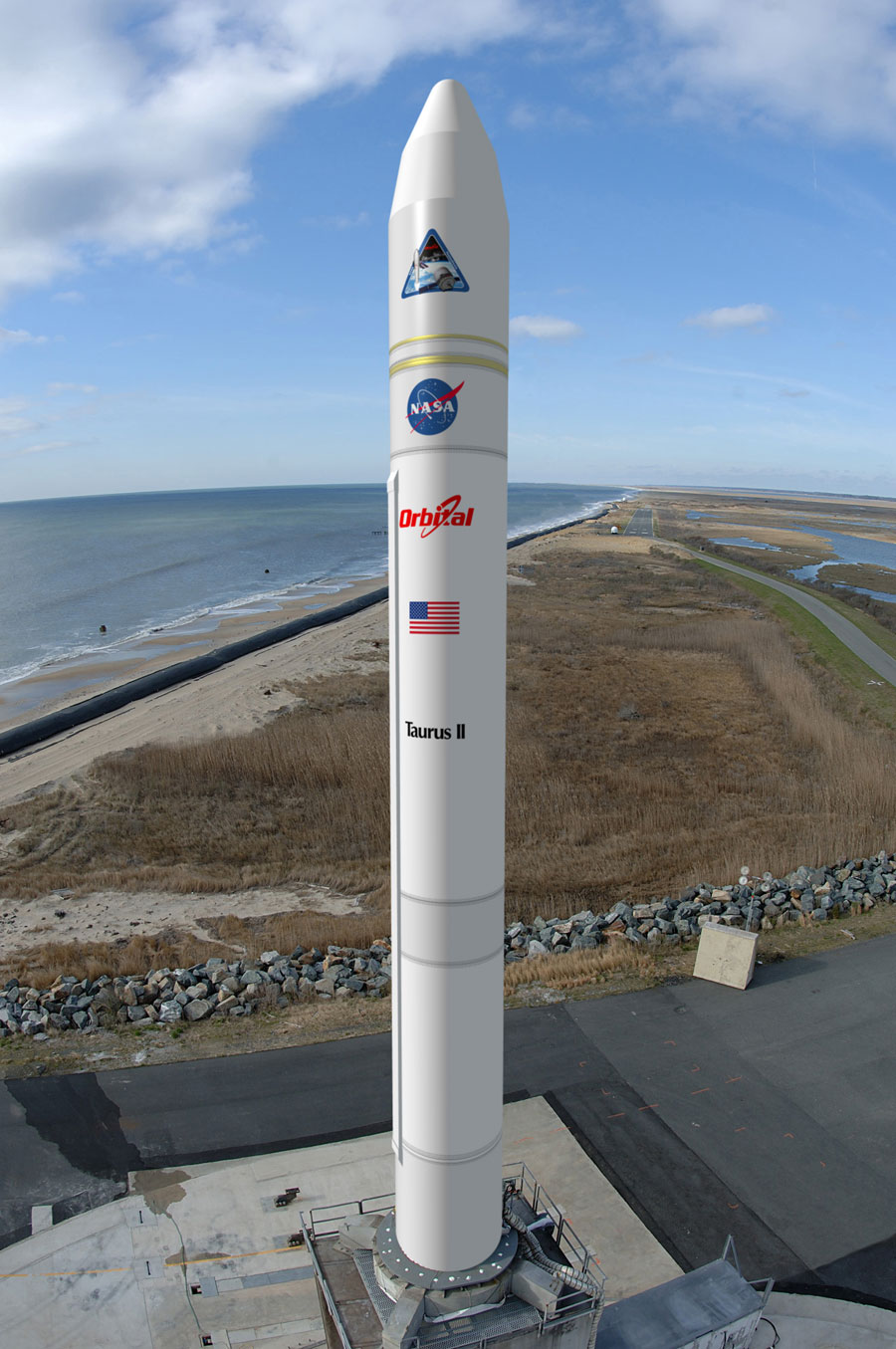- Taurus II
infobox rocket
caption = An artist's rendering of the Taurus II at theMid-Atlantic Regional Spaceport
function = Mediumexpendable launch system
manufacturer = Orbital Sciences
country-origin =United States
height =40 m [ [http://www.geocities.com/launchreport/v200712.html Space Launch Report Vol 2007, Issue 12] ]
alt-height =131 ft
diameter =3.9 m [ [http://www.orbital.com/AdvancedSpace/AdvancedLaunchSystems/TaurusII/ Taurus II - Orbital Sciences Corporation] ]
alt-diameter =12.8 ft
mass = ~240,000 kg [ [http://www.geocities.com/launchreport/v200712.html Space Launch Report Vol 2007, Issue 12] ]
alt-mass =530,000 lb
stages = 2 to 3 [ [http://www.orbital.com/NewsInfo/Publications/TaurusII_fact.pdf Taurus II Fact Sheet - Orbital Sciences Corporation] ]
LEO-payload = 5,750kg [ [http://www.orbital.com/AdvancedSpace/AdvancedLaunchSystems/TaurusII/ Taurus II - Orbital Sciences Corporation] ]
comparable =Athena III Delta II
status = Development
sites = Pad 0A, MARS
first=Scheduled for 2010
payloads = CygnusTaurus II is an American medium-capacity
expendable launch system , being developed byOrbital Sciences Corporation as an alternative to, and potential replacement for, theUnited Launch Alliance Delta II .NASA awarded to Orbital a COTS contract to launch cargo missions to theInternational Space Station . Under this contract, the Taurus II will be used to launch theCygnus spacecraft . It is scheduled to make its first flight in 2010. [http://www.nasaspaceflight.com/content/?cid=5361 NASASpaceflight.com - Orbital beat a dozen competitors to win NASA COTS contract] ] In addition, the vehicle would compete for small-to-medium missions ["Aviation Week and Space Technology, Feb. 25, 2008, p. 22"] .Development
Thirteen firms submitted bids;
NASA selected five finalists: Andrews Space, Boeing, PlanetSpace, Spacehab, and Orbital Sciences Corporation. On19 February 2008 , NASA announced that Orbital's Taurus II/Cygnus spacecraft had won the COTS cargo launch services contract. They are scheduled to make their first flight together in 2010. [http://www.nasaspaceflight.com/content/?cid=5361 NASASpaceflight.com - Orbital beat a dozen competitors to win NASA COTS contract] ] In addition, the vehicle would compete for small-to-medium science and technology-demonstrator missions.The award is for US$171 million; Orbital expects to invest $150 million in addition, split between $130 million for the booster and $20 million for the spacecraft ["B. Bergen, Space News, February 25, 2008, p. 12"] .
On
10 June 2008 it was announced that theMid-Atlantic Regional Spaceport , part of theWallops Flight Facility inVirginia , would be the primary launch site for the rocket. [ [http://www.msnbc.msn.com/id/25067069/ Governor Kaine announces 125 new jobs for Virginia] ] Launch pad 0A, which is the former launch pad for the failed Conestoga rocket will be modified to handle the Taurus II. [ [http://spaceports.blogspot.com/2008/06/taurus-2-launch-pad-to-be-ready-in-18.html Taurus-2 Launch Pad to be Ready in 18-Months at Wallops Island Spaceport] ] A launch from Wallops would reach the International Space Station's orbit as effectively as from Cape Canaveral, Florida, while being less crowded ["B. Bergen, Space News, February 25, 2008, p. 12"] [ [http://hamptonroads.com/2008/02/wallops-big-role-firms-nasa-contract The Virginian-Pilot - Wallops up for big role with firm's NASA contract] ] . It is currently planned for the first Cygnus flight to be an unloaded demonstration; the first Cygnus flight may or may not be the first Taurus flight, pending additional bookings.Layout
The first stage will be a kerosene/oxygen rocket, powered by two NK-33s (remarketed by
Aerojet as the AJ-26). As Orbital has little experience with large liquid stages and LOX propellant, some amount of work will be contracted to NPO Yuzhnoye, designers of the Zenit series. One source claims that the amount will include "main-stage fuel tanks and associated plumbing" ["B. Bergen, Space News, February 25, 2008, p. 12"] . It appears at this time that the vehicle will share the 3.9 meter diameter of Zenit.The second stage is a solid, the Castor 30, to be developed by
ATK as a derivative of the Castor 120 solid stage. The third stage is ahypergolic stage, to be developed by Orbital as a derivative of prior missions. The hardware will be derived from onboard thruster systems of the OSC Star 2 bus; other elements will use knowledge from the DART mission, of which OSC was the prime contractor ["B. Bergen, Space News, February 25, 2008, p. 12"] . Exact parameters may change as the vehicle develops.This hypergolic propulsion system is planned to form the basis of the
Cygnus spacecraft . The equipment section will likely be topped by a smaller development of theMPLM for pressurized cargo, and possibly a derivative of theExPRESS Logistics Carrier for unpressurized cargo. Initial production of pressurized modules will take place in Italy. No reentry and return capabilities are planned so far, but as with the rest of the project, details are still subject to change ["B. Bergen, Space News, February 25, 2008, p. 12"] .ee also
*
Commercial Orbital Transportation Services
*Cygnus spacecraft
*NASA
*Orbital Sciences Corporation
*Taurus rocket References
Wikimedia Foundation. 2010.

